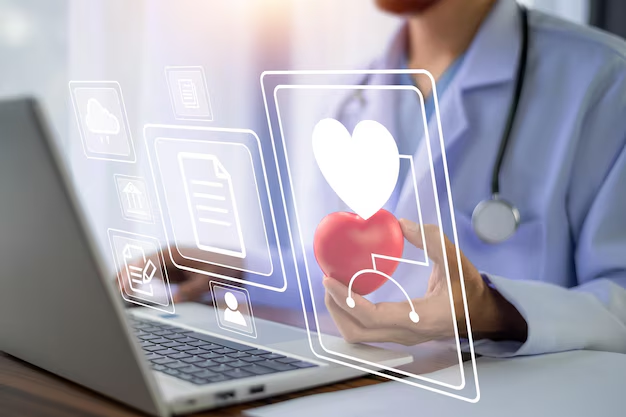Healthcare is undergoing a transformation, thanks to the integration of digital technologies that are enhancing patient care, improving accessibility, and streamlining the healthcare process. Digital health management refers to the use of digital tools and technologies to manage health, prevent disease, and optimize patient care. From telemedicine and wearable devices to electronic health records (EHRs) and artificial intelligence (AI), digital health is revolutionizing how healthcare is delivered and experienced.
In this article, we will explore the key components of digital health management and how they are shaping the future of healthcare.
1. Telemedicine: Bridging the Gap in Healthcare Access
Telemedicine, or the remote delivery of healthcare services through digital platforms, has grown rapidly in recent years, especially due to the COVID-19 pandemic. This technology allows patients to consult with doctors via video calls, phone calls, or even text, reducing the need for in-person visits and enabling access to healthcare services in underserved or remote areas.
Benefits of Telemedicine:
- Accessibility: Patients in rural or remote areas can easily connect with healthcare providers, reducing the need to travel long distances for consultations.
- Convenience: Telemedicine allows patients to receive care from the comfort of their homes, saving time and reducing the burden on hospitals and clinics.
- Cost-Effectiveness: By minimizing in-person visits and overhead costs, telemedicine can reduce the overall cost of healthcare, benefiting both patients and providers.
- Specialist Access: Telemedicine makes it easier for patients to consult with specialists who may not be available locally, improving access to expert care.
2. Wearable Devices: Monitoring Health in Real-Time
Wearable health devices have become an essential tool for individuals who want to monitor and manage their health proactively. These devices, such as fitness trackers, smartwatches, and medical-grade wearables, allow users to track vital signs like heart rate, blood pressure, blood glucose levels, sleep patterns, and physical activity in real-time.
Popular Wearable Health Devices:
- Fitness Trackers: Devices like Fitbit, Apple Watch, and Garmin track physical activity, monitor sleep, and even measure heart rate, helping users stay on top of their fitness goals.
- Continuous Glucose Monitors (CGMs): For patients with diabetes, CGMs provide real-time monitoring of blood sugar levels, helping to prevent dangerous spikes or drops.
- Smartwatches: Modern smartwatches like the Apple Watch and Samsung Galaxy Watch offer features like ECGs (electrocardiograms) and fall detection, allowing users to track their heart health and detect potential emergencies.
Impact on Healthcare:
- Proactive Health Monitoring: Wearables enable individuals to track their health on a daily basis, helping them make informed decisions about their wellness and seek medical attention when necessary.
- Chronic Disease Management: Wearables allow patients with chronic conditions to monitor their health metrics, such as blood sugar levels, blood pressure, or heart rate, and share this data with healthcare providers for better disease management.
- Preventative Care: By tracking lifestyle habits and vital signs, wearables can help detect early signs of health issues, promoting a proactive approach to healthcare rather than a reactive one.
3. Electronic Health Records (EHRs): Improving Data Sharing and Patient Care
EHRs have become a fundamental component of modern healthcare systems. These digital records store patient information in an electronic format, enabling seamless sharing of medical history, test results, prescriptions, and other vital health data among healthcare providers.
Benefits of EHRs:
- Streamlined Communication: EHRs enable healthcare providers to access and share patient information quickly, improving communication between primary care doctors, specialists, and hospitals. This ensures coordinated care and reduces the likelihood of medical errors.
- Improved Accuracy: With EHRs, the risk of lost or misinterpreted information is minimized, as all patient data is stored in one digital location and is easily accessible.
- Better Decision-Making: EHRs can provide healthcare professionals with up-to-date patient information, helping them make informed decisions about treatment plans and interventions.
- Patient Empowerment: EHR systems often allow patients to access their own health records online, promoting transparency and enabling them to take a more active role in managing their health.
4. Artificial Intelligence (AI) and Machine Learning: Enhancing Diagnosis and Treatment
AI and machine learning are transforming healthcare by enabling more accurate diagnoses, personalized treatment plans, and predictive analytics. These technologies can analyze large amounts of data—such as medical images, patient records, and genetic information—to identify patterns and predict health outcomes.
Applications of AI in Healthcare:
- Diagnostic Assistance: AI algorithms can analyze medical images (such as X-rays, MRIs, and CT scans) to detect abnormalities, such as tumors, fractures, or other diseases, often with greater accuracy than human doctors. For example, AI is already being used in early cancer detection and ophthalmology.
- Predictive Analytics: Machine learning models can predict the likelihood of certain health conditions based on a patient’s history and demographic data. For example, AI can forecast the risk of heart disease or diabetes, enabling preventive measures.
- Personalized Medicine: AI is being used to tailor treatment plans to individual patients based on their genetic makeup, lifestyle, and medical history. This approach leads to more effective and personalized care, especially in areas like cancer treatment and mental health.
5. Health Apps: Empowering Patients to Take Control of Their Well-Being
Mobile health applications (mHealth apps) allow users to track, monitor, and improve their health by providing access to medical resources, health records, fitness goals, and more. These apps cover a wide range of needs, from general wellness to chronic disease management, mental health, and medication adherence.
Popular Health Apps:
- Fitness Apps: Apps like MyFitnessPal, Strava, and Nike Training Club help users track exercise routines, nutrition, and fitness goals.
- Mental Health Apps: Apps like Headspace, Calm, and BetterHelp offer mental health support, meditation, therapy sessions, and stress management techniques.
- Medication Management: Apps such as Medisafe remind patients to take their medications on time, reducing the risk of missed doses and medication errors.
Impact on Patient Engagement:
- Self-Monitoring: Health apps encourage individuals to track their habits, exercise, diet, and mental health, fostering a sense of responsibility and empowerment over their own well-being.
- Personalized Recommendations: Many health apps use data to offer personalized recommendations for diet, exercise, and lifestyle changes, helping users achieve their health goals.
- 24/7 Access to Healthcare Information: mHealth apps provide users with access to healthcare advice and information at any time, improving accessibility to healthcare resources.
6. Blockchain: Ensuring Security and Privacy in Health Data
As the healthcare industry digitizes, ensuring the security and privacy of sensitive health data becomes increasingly important. Blockchain technology provides a secure and transparent way to store and share health information while maintaining patient privacy.
Benefits of Blockchain in Healthcare:
- Data Security: Blockchain’s decentralized nature makes it difficult for hackers to alter or steal sensitive patient data, ensuring that health information remains secure.
- Interoperability: Blockchain allows various healthcare providers to share patient data seamlessly, even if they use different systems, improving care coordination and reducing administrative costs.
- Patient-Controlled Data: With blockchain, patients can have more control over who accesses their health data and can grant or revoke permissions as needed.
7. The Future of Digital Health Management
The future of digital health management looks promising, with continuous advancements in technology that will shape the healthcare landscape for years to come. Key trends to watch include:
- Virtual Health Assistants: AI-powered virtual assistants will continue to assist patients with scheduling, medication reminders, and health advice, making healthcare more accessible and efficient.
- Precision Medicine: Advancements in genomics, AI, and big data analytics will lead to more precise and personalized treatment options, particularly in the areas of oncology, genetics, and rare diseases.
- Blockchain Adoption: As blockchain technology matures, it will become increasingly used to protect patient data, improve interoperability, and ensure transparency in healthcare systems.
- Integration of 5G Networks: The widespread rollout of 5G technology will enhance the performance of telemedicine, remote monitoring, and real-time data sharing, enabling faster and more efficient healthcare delivery.
8. Conclusion: Transforming Healthcare Through Digital Innovation
Digital health management is reshaping the healthcare industry, offering numerous benefits to both patients and providers. By embracing technologies such as telemedicine, wearable devices, AI, and blockchain, healthcare systems are becoming more efficient, accessible, and personalized. These innovations not only improve patient care but also promote preventative healthcare, reduce costs, and empower patients to take control of their health.
As technology continues to evolve, the future of healthcare will be increasingly digital, interconnected, and patient-centric. By leveraging these advancements, we can create a healthcare ecosystem that is more responsive, efficient, and sustainable, ultimately leading to better health outcomes for individuals around the world.

